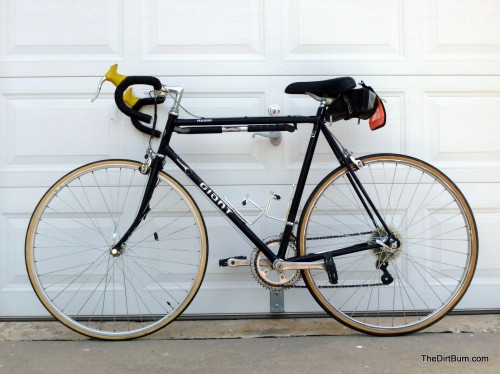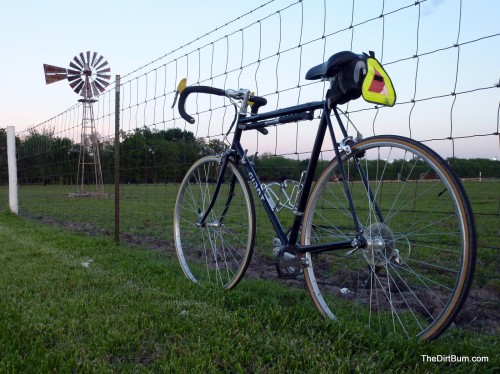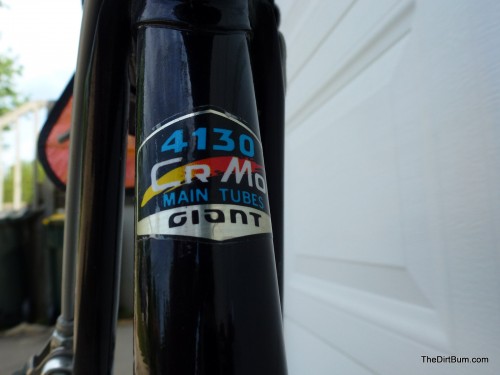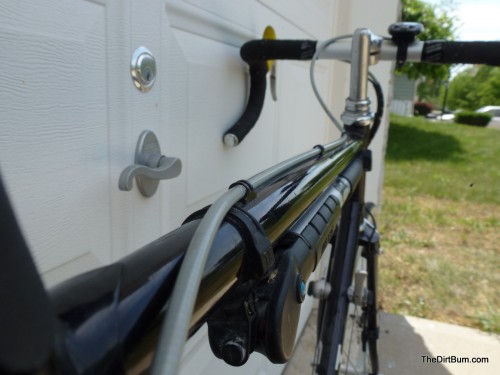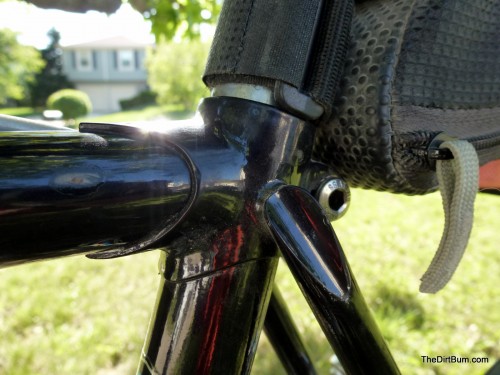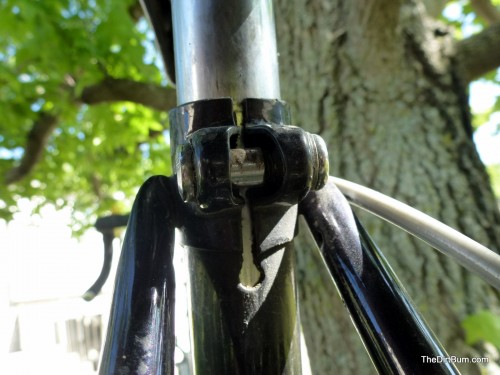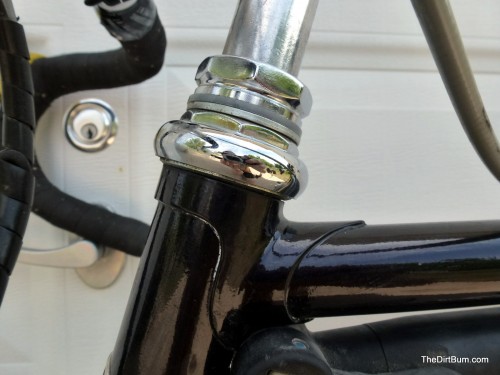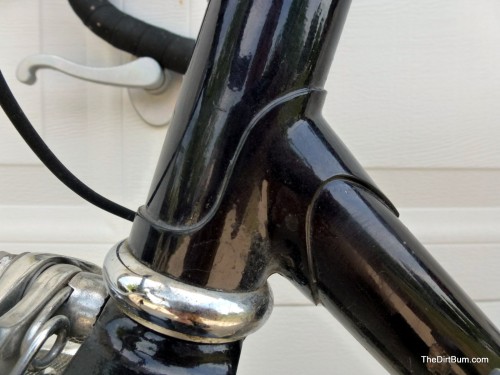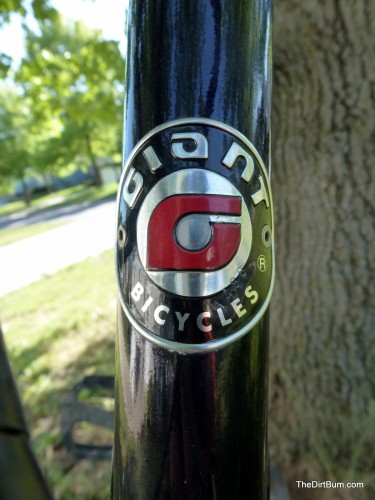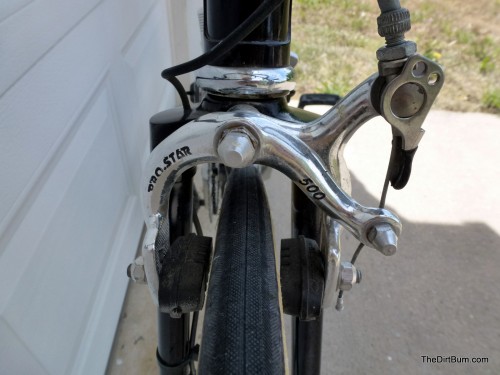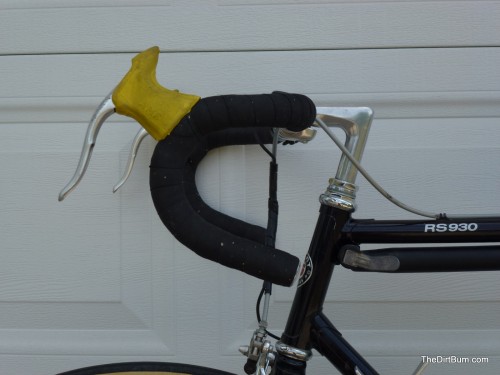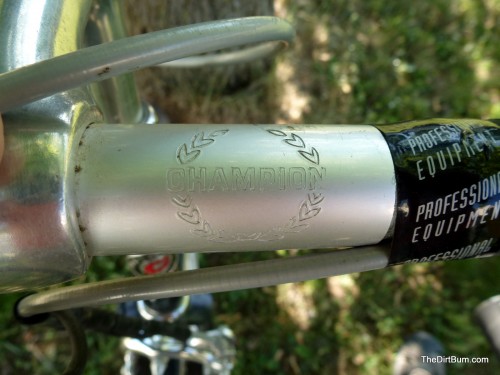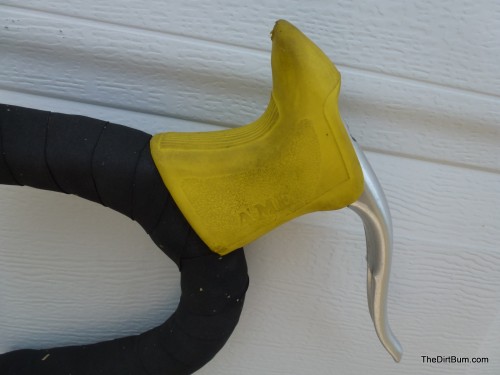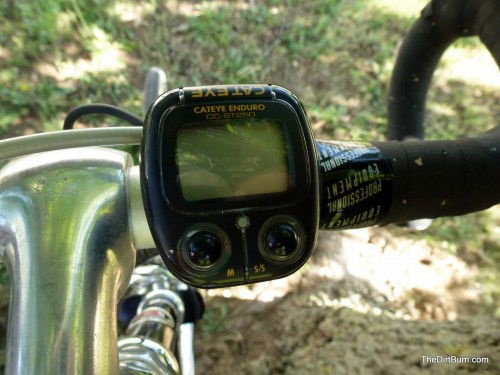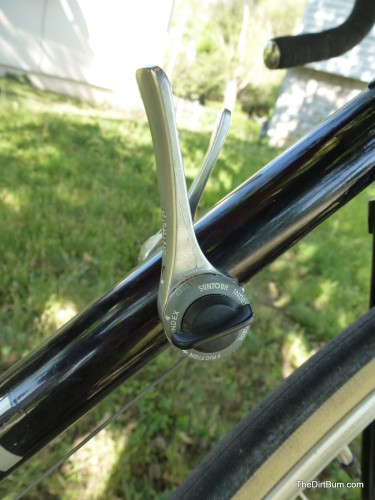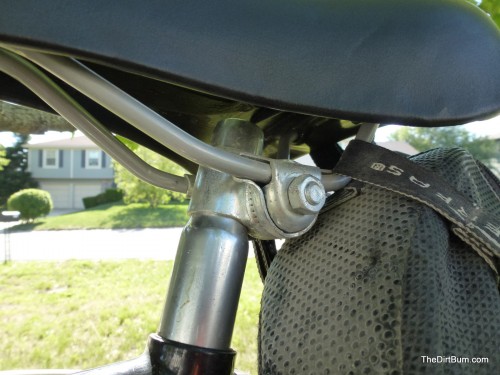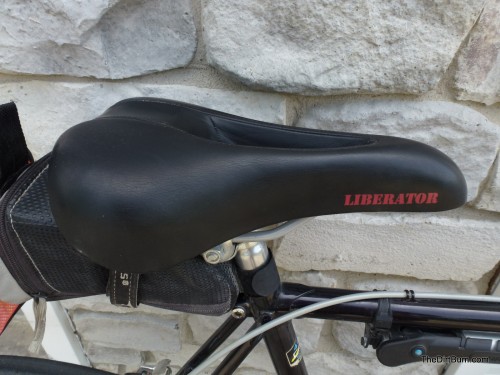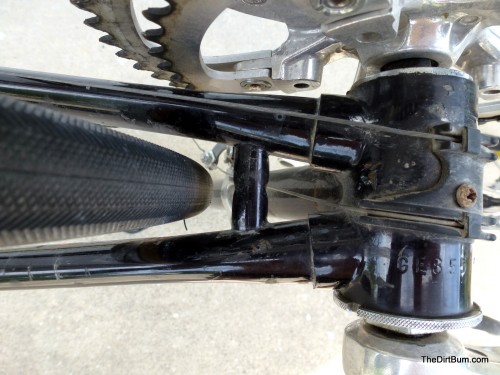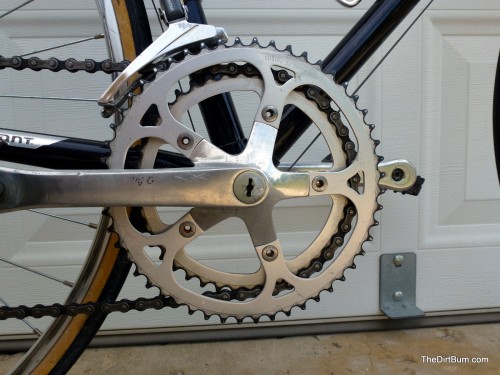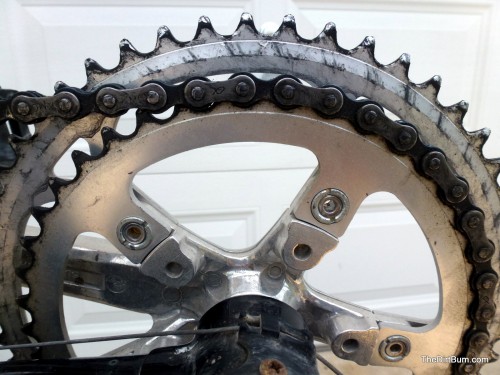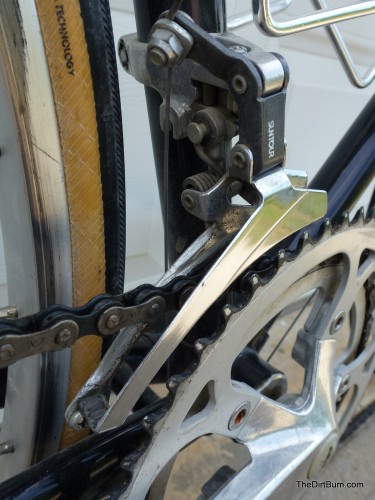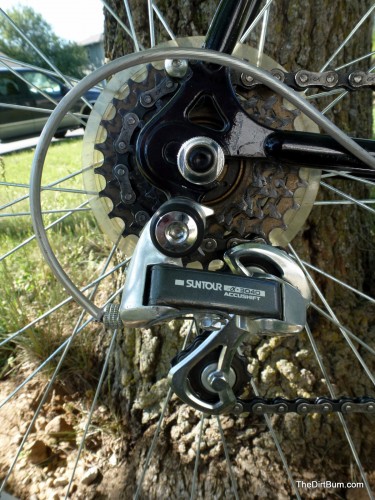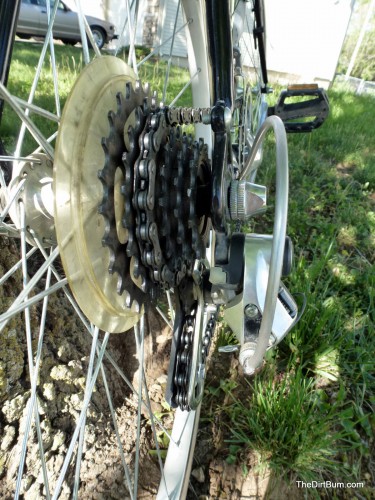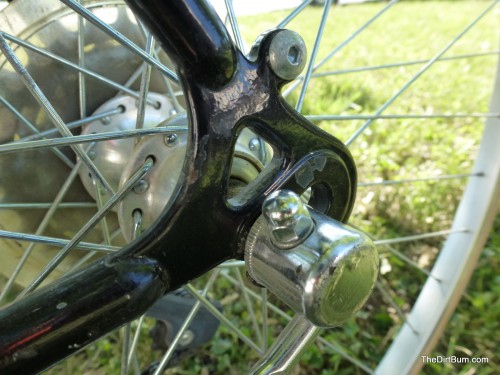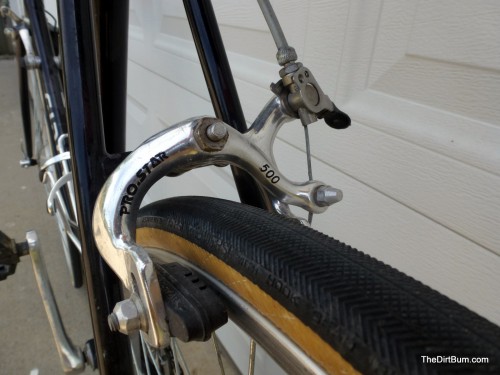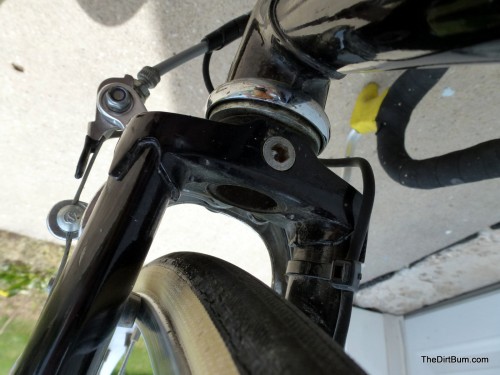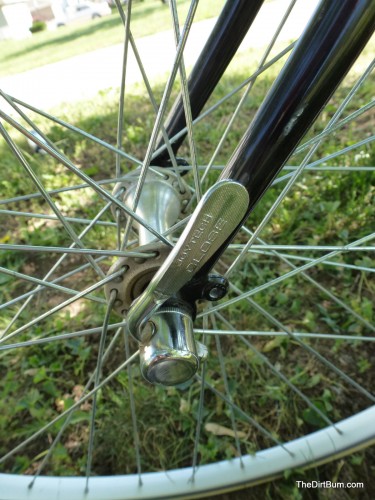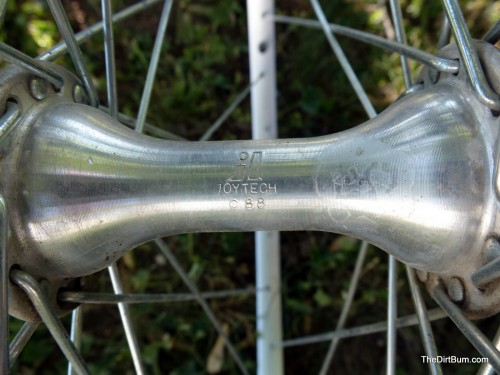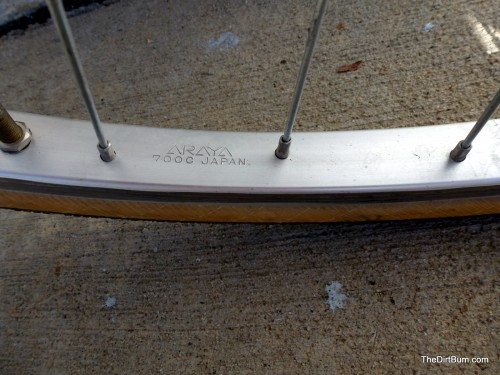After my last ride I noticed a problem with the rear hub on my Puch Cavette II, so I dropped it off at a local bike shop, and persuaded them to let me borrow a bike I was considering as a possible replacement. It’d give me a few days to evaluate the bike, and see if it was what I wanted.
The bike was a 1988 Giant RS930. This was apparently one of the first years that Giant had their own line of bikes in America (previous to that, they’d primarily made bikes that were sold as Schwinns).
It’s a lugged steel frame. A decal on the frame says “4130 CrMo Main Tubes”. “4130 CrMo” refers to chromium-molybdenum (AKA chromoly), a steel alloy used in higher-quality frames. By “main tubes”, I presume that means that the top tube, seat tube, and down tube are 4130, while the other tubes (chain stays, seat stays, head tube, and fork) are something else, probably high-tensile carbon steel.
As such, the RS930 should be somewhat lighter than the Puch Cavette II frame, which is made of “Special Puch 482 Tubing”, which is, I believe, basically high-tensile carbon steel.
In addition to the differences in frame material, the Giant has 700C wheels (compared to the Puch’s 27″ wheels), downtube rather than stem-mount shifters, a 6-speed freewheel rather than 5-speed, and a shorter chainstay, for a slightly more “road-ish” geometry, compared to the Puch’s “sport-touring” geometry.
Here are a couple shots of the bike as a whole:
I’m not sure if you can see it in the pictures, and it’s sometimes difficult to discern even in real life, but the paint color is not black, but a deep, deep purple. I don’t really care for the color, but otherwise it’s a nice-looking machine. Clean, classic lines. Very simple.
Here are some detail shots of the components (this is provided mostly as a reference for others who may be researching the Giant RS930):
This is the “4130 CrMo Main Tubes” label.
A look at the top tube, showing the brazed-on cable guides. There’s pump peg on the head tube beneath the top tube. The rear of the pump (this is my Park Tool frame pump) is held by a plastic clamp-on Zefal pump peg.
Here’s the seat tube area, where the seat tube, top tube, and seat stays meet. The lugs are clean and simple and functional, but not especially attractive.
A close-up of the seat tube clamp and seat stay welds.
A close-up of the head tube top lug, headset, and base of the stem.
Head tube bottom lug.
The Giant head badge, showing the date code “1488” (14th week of 1988).
Detail of the front brake, a Pro-Star 500. Don’t know much about this brake, but it seems pretty generic. The quick-release wouldn’t move, and I didn’t want to force it. The brakes worked well, though.
Profile shot of the handlebars, head tube, stem, etc.
The handlebar was marked as “Champion”, no model number that I could see. I was a bit surprised that it was a steel bar, rather than aluminum.
The brake levers were unmarked. The hoods were “A’ME”. They were fairly comfortable.
The bike included a Cateye Enduro CC-ST250 cyclocomputer. It wasn’t working, but just needed a fresh battery, I assume.
The shifters were mounted on the downtube, and were SunTour brand that worked in either indexed or friction mode. I switched ’em over to friction, and they shifted quite well. This is the first bike I’ve ridden with downtube shifters. There’s definitely an acclimation period, but they worked fine once I got use to them.
The seat tube was an odd touch. I always associated this saddle clamp style with lower-end el-crapo bikes, but I guess it works…
The saddle was a TFI (Terry) Liberator, with a large center cutout. I think that might be real leather. It was perhaps too soft for my liking, but reasonably comfortable, at least on short rides.
This photo shows the bottom bracket area, with plastic cable guides. The rear tire was a 26mm; looks like it might work with up to a 32mm tire (28mm with fenders).
The crank arms and chain rings (52/42) from the front and back. Not sure what the cranks were. The dustcaps read “Sugino”.
The front derailleur was a SunTour, but was otherwise unlabeled. It appears to match the rear derailleur in styling, though.
The rear derailleur is a SunTour α (alpha) 3040 Accushift. I believe this was the 2nd generation of SunTour’s indexed shifting system. It worked fine.
A look at the rear freewheel gear cluster. I believe the sprockets were 13-15-17-20-24-28, for a gear-inch range of 40 to 105 inches. Not particularly wide, but plenty for the roads I took it on.
Here’s the quick-release on the rear wheel. The drop-outs (front and rear) are forged, not stamped. They’re not the highest quality, but pretty good.
This is the rear brake, another Pro-Star 500. This QR worked fine, as did the brakes themselves.
This is a look at the underside of the fork crown — solid if unspectacular. Plenty of tire and fender clearance here.
The Joytech brand quick-release on the front wheel.
The Joytech front hub (and rear as well), seemed to be of very good quality. Again showing the “88” date code.
The rims were Araya 700C. Plain, but decent quality, as I understand.
The tires were apparently pretty old. I suffered two flats on the front tire. The first time I took the bike on gravel, a rock pierced the sidewall. I booted it and patched the tube, and it held, but that was disconcerting. The second time was a snakebite after I hit a pothole. Again, I patched the tube and it held. The front tire was a 25mm width, and I think that’s probably just too narrow for my riding style. The ride was harsher than I prefer, and I don’t want to have to worry about the fragility of the tires, no matter whether I ride on pavement, gravel, or worse. I suspect that new, wider tires would solve that problem easily enough.
On the rear, I had one flat. I went to air it up, and the pump got stuck on the valve stem, and tore it right out of the rim. Just a very old tube, I expect. Replaced it, and went on, with no further issues.
Conclusion
After my Puch was repaired, I ended up taking the Giant back and leaving it.
It definitely had a more active and responsive feel to the ride, which is what I was looking for. The ride was rather harsh, but I attribute that mostly to the narrow, high-pressure tires. The styling was clean, but uninspiring. The bike felt kind of generic.
Performance-wise, I rode it on the same “time trial” course I took the LHT and Puch on. It came in at 14:27 — basically the same time as the Puch. So no real advantage there, at least on this one short test.
Weight-wise, the Giant ended up being about 3 pounds lighter than the Puch Cavette II. With pump and seatbag, the Puch was at 32.4 pounds, and the Giant was at 29.4 pounds. Lighter, but not as big of a difference as I’d hoped for (with better tubing and lighter wheels and tires).
In the end, I decided that I liked the bike, but didn’t love it.
The Puch is definitely prettier, and has a better pedigree (or at least a heritage that appeals to me more). The Giant is “OK”. I’m sure I could ride it and be happy with it, but I didn’t find it very inspiring.
If I were giving the bikes a score, I’d rate the Puch Cavette II at 5/10, and the Giant RS930 a 6/10. Better, but is it worth switching for?
So I guess I’ll keep looking for that “next step” upgrade bike. I want something as beautiful as the Puch, but better performance, and higher quality and more elegant aesthetics than the Giant.
